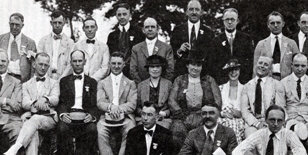The Beginnings of a Formal Organization As a part of the celebration of the Indianapolis club’s first anniversary, representatives from all the other known clubs were invited to a conference in the Indiana city in May of 1917. On the 18th and 19th of that month delegates from 13 clubs—Indianapolis, Louisville, St. Louis, Milwaukee, Denver, Chicago, Los Angeles, Washington, D.C., Peoria, Minneapolis, Springfield, Baltimore and St. Paul—gathered, without authority to act on behalf of their respective clubs, to discuss the possibility of formalizing a national organization. Though not a convention in any sense of the word, the conference did generate a new feeling of unity and general awareness of the great potential in optimism. As one delegate wrote afterward, “Harmony was the keynote and every delegate seemed much impressed with the future of this new venture.” But it was not to be. The clouds of World War I were rolling over the United States and the hopes of organizing optimism were beginning to fade. Optimism Gets Dealt a Heavy Blow By the spring of 1917, the United States was mired in the First World War, and by autumn of 1918 all major industries had either converted to war work or were practically out of business. The cost of living had jumped 17 percent, sugar was being rationed and people were saying that what the war didn’t get the influenza epidemic would. By November, and the Armistice, shortages were reported in everything from beans to baseball (the season had been cut short by order of the Secretary of War). Few Americans were thinking optimistically and fewer still were interested in joining a club of optimists. The older clubs were becoming dissatisfied with the American Optimists Clubs, largely because of a group of professional organizers who had assumed control of the organization. Some clubs began to talk of secession from the national group and of forming their own organization. The members of the Kansas City club felt that the Optimist movement was a thing of such value that a new nationwide organization should be established. As a result, a non-profit corporation was formed known as the American Optimist Club and letters were sent to all known clubs asking them to join in a first convention. Most clubs indicated their willingness to participate; however, the Indianapolis club suggested that the meeting be held there rather than in Kansas City since national headquarters had formerly been located there. All concurred in the merits of the suggestion and a conference of the disgruntled clubs was scheduled for March 1919 in Indianapolis. This may have been the most crucial meeting of club delegates in the history of Optimism. That anyone would be able to get representatives from any dissatisfied group to journey across the country via train to discuss their peeves was in itself a major phenomenon and an exhibition of the fundamental spirit of optimism that infused those individuals. |
| The 11 clubs represented at this meeting nullified the secession notions, settled their differences and chose a new name for the organization: the International Optimist Club. Incorporation papers were filed with the Indiana Secretary of State and a temporary slate of national officers was appointed. Delegates returned to their clubs with a revitalized spirit of Optimism. Above all, the seed that would later become Optimist International had been planted. A national convention, the first, was called for June 19 and 20 of that year, to be held in Louisville, Kentucky. Little did those dozen or so Optimists realize what their decision to meet again would lead to. |
 Optimists gather at the first convention of Optimist International in June 1919. |